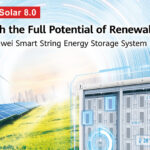
Department seeks legal advice over missed first carbon budget timeframe
29th January 2024
Huawei Ireland FusionSolar: Elevating solar energy solutions
29th May 2024B9 Energy Storage project: ‘NI/GB Green Shipping Corridor’ funded by IUK/DfT CMDC r4 strand 3

This project sets out to investigate the feasibility of establishing a ‘NI/GB Green Shipping Corridor’ between Larne in Northern Ireland and Liverpool in the North West of England using a ro-ro freight ferry design optimised for the carriage of unaccompanied trailers and powered by hydrogen reformed onboard from green methanol delivered in road mobile ISO tank containers. The green methanol would be synthesised in the Port of Larne from green H2 and CO2 as part of the Ballylumford Power-to-X Project, see description below. The main innovation in the project is to capture CO2 from the onboard reformer and return it to the methanol synthesis plant in the same tank containers that delivered the methanol, thereby setting up a circular CO2 economy that avoids the inevitable future supply constraint of green CO2. The port based flexible green methanol plant will use otherwise curtailed wind power to drive a flexible electrolyser that feeds green hydrogen to a catalytic reactor. The Domestic Green Shipping Corridor would have ‘true-zero’ emissions, would not be reliant upon limited supplies of bio derived CO2 or direct air captured CO2 and would not need any carbon offsetting to meet net zero objectives.
Other Unique Selling Points (USPs) include:
- Emissions from circa 180 HGV tractor units, each driving a 400-mile round trip between e.g. Cairnryan and Liverpool would be avoided.
- Green methanol reforming with hydrogen fuel cell power generation (‘true-zero carbon’) has overall efficiency at circa 60%, which is significantly higher than combustion at circa 40%.
- When water produced in the fuel cells is fed back and mixed with the methanol supply to the reformer, 30% to 40% more green H2 is liberated than from methanol alone.
- No post combustion NOx, SOx or particulates to manage.
- Balancing electrical load for otherwise curtailed wind farms improves wind farm up-time, reduces revenue loss and business interruption, restores wind farm investor confidence and allows future additional wind capacity to contribute to decarbonisation of the Northern Ireland economy.
- Methanol is readily available as a marine fuel and is becoming the preferred option for an increasing number of ship owners, especially for container ships and ro-ro freight ferries on corridors longer than 100NM.
- Green methanol is an eligible marine fuel in the UK DfT’s Renewable Transport Fuel Obligation support scheme. Methanol is not approved under the International Convention of the Safety of Life at Sea (SOLAS) or the International Code of Safety for Ships using Gases or other Low-flashpoint Fuels (IGF Code). However, the International Maritime Organisation (IMO) approved in November 2020 at the 102nd session of the Maritime Safety Committee (MSC 102), Interim Guidelines for the safety of Ships using Methyl/Ethyl Alcohol as fuel (methanol/ethanol respectively).
- Rules and regulations need to be put in place to ensure satisfactory HSE outcomes onboard ships. There are currently no Interim Guidelines issued by IMO on either Ammonia or Hydrogen to be used as fuel.
- Methanol is a liquid at ambient conditions, has a higher volumetric energy density than either compressed hydrogen or liquid hydrogen and can be stored, transported and transhipped at low pressure and low cost.
Ballylumford Power-to-X Project:
The routes to market for green hydrogen in Northern Ireland were comprehensively explored and characterised through the B9 Energy led, BEIS funded, ‘Ballylumford Power-to-X Project’ and these include i) local blending into natural gas transmission pipelines, ii) local fuel supply for existing CCGT power-stations, iii) compression for distribution to industry and mobility using tube trailers, iv) circular economy offtakes for e-fuel production (e-methanol, e-diesel, e-Kerosene) and use as a feedstock for existing markets of plastic synthesis (e-methanol) and fertiliser production (e-ammonia). Ballylumford is also the location of a proposed 500 million m3 (STP) salt cavern storage facility that can be used to store green hydrogen in support of H2 blending and power generation.
Of these routes to market, the one that offers the largest and fastest growth in electrolyser capacity, and so is more able to rapidly restore wind farm investor confidence, is currently seen as e-methanol for supply as a fossil bunker fuel substitute in the ro-ro freight ferry sector that serves the Northern Ireland trade routes to NW England.
David Surplus
Managing Director
B9 Energy Storage
